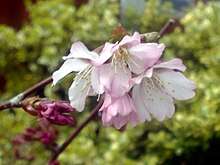Prunus nipponica
Prunus nipponica, also called Japanese alpine cherry (高嶺桜, Takanezakura), is a shrub which originates from the islands of Hokkaido and Honshu, Japan.[1] It grows to a height of about 5 meters (16 ft) and can grow in sandy, loamy, and clay soils.[2]
| Prunus nipponica | |
|---|---|
 | |
| Scientific classification | |
| Kingdom: | |
| (unranked): | |
| (unranked): | |
| (unranked): | |
| Order: | |
| Family: | |
| Genus: | |
| Subgenus: | P. subg. Cerasus |
| Section: | P. sect. Pseudocerasus |
| Species: | P. nipponica |
| Binomial name | |
| Prunus nipponica | |
| Synonyms | |
| |
This species is one of the hardiest of cherry trees, well-suited to cold climates. The flowers are a very light pink or even white in color.[3] Flowers bloom in the first half of spring. They have 5 petals and are 3 centimeters (1.2 in) in diameter. The pistils are usually longer than the stamen. The leaves are serrated and the bark is gray.[4] In autumn the leaves turn yellow and orange-red; these are rare autumnal colors for a cherry tree.[5][6][7]
P. nipponica wood contains significant amounts of these flavonoids: d-catechin, naringenin, sakuranetin, eriodictyol, taxifolin, genistein, and prunetin.[8] Being a member of the genus Prunus, P. nipponica would contain amygdalin and prunasin which form hydrocyanic acid when combined with water. This acid is poisonous but in very small doses it can improve respiration, digestion, and a sense of well-being. The fruit can be used as food and to make green dye.[2]
This species was first reported by Japanese botanist Jinzō Matsumura in the Tokyo Botanical Magazine in 1901.[9] It is in the section Pseudocerasus of the cherry subgenus Cerasus of the genus Prunus, which are ornamental plants. Ma et al classified it in a group with Prunus incisa.[10] P. nipponica is on the "List of Protected Animals and Plants in the Wildlife Protection Zone" of the wilderness Shirakami-Sanchi World Heritage Site.[11]
Varieties
Varieties include P. nipponica var. nipponica, P. nipponica var. kurilensis,[3] and P. nipponica var. Chishima-zakura.[4]
References
- "Prunus nipponica". Germplasm Resources Information Network (GRIN). Agricultural Research Service (ARS), United States Department of Agriculture (USDA). Retrieved January 28, 2014.
- "Prunus nipponica - Matsum". Plants for a Future. Retrieved January 28, 2014.
- "Prunus nipponica var. kurilensis - Japanese alpine or Kurile cherry". Mustila Arboretum. Retrieved January 28, 2014.
- "Sakura The Flowering Cherries of Japan". Pennsylvania State University. Retrieved January 29, 2014.
- Flint, Harrison L. (1997). Landscape Plants for Eastern North America. New York: John Wiley & Sons. p. 493. ISBN 0-471-59919-0.
- "The Better Oriental Cherries". Arnoldia. Arnold Arboretum, Harvard University. 10 (3). 1950.
- https://www.rhs.org.uk/Plants/325249/Prunus-nipponica-var-kurilensis-Brillant/Details
- Hasegawa, Maseo (1957). "Flavonoids of Various Prunus Species. VI. The Flavonoids in the Wood of Prunus aequinoctialis, P. nipponica, P. Maximowiczii and P. avium". Journal of the American Chemical Society. 79 (7): 1738–1740. doi:10.1021/ja01564a056.
- Hedrick, U. P-. (1915). The Cherries of New York. Albany, NY: New York Department of Agriculture. p. 20.
- Ma, Hongmei; Olsen, Richard; Pooler, Margaret (2009). "Evaluation of Flowering Cherry Species, Hybrids, and Cultivars Using Simple Sequence Repeat Markers". Journal of the American Society for Horticultural Science. 134 (4): 435–444.
- "List of Protected Animals and Plants in the Wildlife Protection Zone". Ministry of the Environment Government of Japan. Retrieved January 29, 2014.
External links
| Wikimedia Commons has media related to Prunus nipponica. |
| Wikispecies has information related to Prunus nipponica |